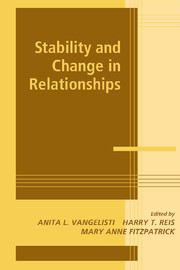Book contents
- Frontmatter
- Contents
- Contributors
- Preface
- PART ONE ACTORS: THE SCAFFOLDING OF STABILITY AND CHANGE
- PART TWO BEHAVIORS: THE PROCESSES OF STABILITY AND CHANGE
- PART THREE CONTEXTS: SOCIAL ENVIRONMENTS FOR STABILITY AND CHANGE
- 11 Social Networks and Change in Personal Relationships
- 12 Creating a Context for Change: Integrative Couple Therapy
- 13 Passionate Love and Sexual Desire: Cultural and Historical Perspectives
- 14 Rules for Responsive Robots: Using Human Interactions to Build Virtual Interactions
- Author Index
- Subject Index
12 - Creating a Context for Change: Integrative Couple Therapy
Published online by Cambridge University Press: 21 October 2009
- Frontmatter
- Contents
- Contributors
- Preface
- PART ONE ACTORS: THE SCAFFOLDING OF STABILITY AND CHANGE
- PART TWO BEHAVIORS: THE PROCESSES OF STABILITY AND CHANGE
- PART THREE CONTEXTS: SOCIAL ENVIRONMENTS FOR STABILITY AND CHANGE
- 11 Social Networks and Change in Personal Relationships
- 12 Creating a Context for Change: Integrative Couple Therapy
- 13 Passionate Love and Sexual Desire: Cultural and Historical Perspectives
- 14 Rules for Responsive Robots: Using Human Interactions to Build Virtual Interactions
- Author Index
- Subject Index
Summary
Although there is little that is more private than the details of a couple's intimate relationship, a couple that has become distressed may decide to “expose” their relationship problems to a helping professional such as a couple therapist. In this way, couple therapists have a unique opportunity to observe the behaviors of couples in distress, and to create an environment for couples that will help facilitate relationship change. Throughout the last few decades, observations and interventions of couple therapists have been studied extensively to better understand factors that contribute to and detract from couples' satisfaction and their capacity for changing problematic behavior. Such research has provided valuable information, not only about the development and maintenance of couple distress, but also about therapeutic approaches that influence behavior change and improve relationship satisfaction.
“CHANGE” AND COUPLE THERAPY
Distressed couples seeking therapy have experienced profound changes in their relationship. They started out happy and hopeful, but over time became increasingly dissatisfied in their relationship (see review of longitudinal research on marriage, Karney & Bradbury, 1997). Compared to their nondistressed counterparts, they are more negative and withdrawn in their behaviors toward one another, have more negative and blaming interpretations of each other's behavior, and have less positive and more negative emotion toward one another (e.g., Weiss & Heyman, 1997).
- Type
- Chapter
- Information
- Stability and Change in Relationships , pp. 285 - 305Publisher: Cambridge University PressPrint publication year: 2002
- 1
- Cited by



